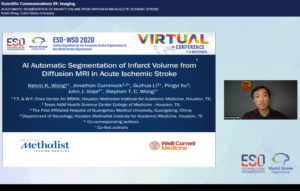 A study presented by Kelvin Wong (Houston Methodist, Houston, US) at the European Stroke Organisation and the World Stroke Organization joint virtual conference (ESO-WSO 2020, 7 –9 November, virtual), has shown that artificial intelligence (AI) can be used to identify stroke infract volume from MRI images.
A study presented by Kelvin Wong (Houston Methodist, Houston, US) at the European Stroke Organisation and the World Stroke Organization joint virtual conference (ESO-WSO 2020, 7 –9 November, virtual), has shown that artificial intelligence (AI) can be used to identify stroke infract volume from MRI images.
In fact, this study showed that in cases with a low Dice score, the AI labelled the segmentation correctly more often than a human expert was able to. The study is a collaboration between John Volpi, Director of Eddy Scurlock Stroke Center, Houston Methodist, Houston, US and Stephen T. C. Wong, Houston Methodist Cancer Centre at Houston Methodist Hospital, Houston, US.
The stroke infraction volume in acute ischaemic stroke (AIS) can be an important variable in predicting a patient’s modified Rankin score (mRs) after 90 days, when used alongside patients’ age and National Institutes of Health stroke scale (NIHSS). This means that being able to segment sections of the brain, through MRI imaging, can be important in assessing a stroke. However, doing this manually can be labour intensive, requires expert training, and requires plenty of practice.
This study included 875 AIS patients who received a diffusion-weighted MRI (DWI) at Houston Methodist Hospital in Texas. Three independent experts would manually segment the infraction volume, with changing infract size and location, including middle cerebral artery stroke, posterior cerebral artery stroke, and anterior cerebral artery stroke.
A rotation-reflection equivariant UNet model was trained on 67 cases and validated on 32. This model was then applied to all cases and segmentation results were manually corrected by three independent experts.
The final model used for the study was based on 80% data and tested on 20% data, and the programme’s performance was evaluated using Dice score.
There have been some developments in this area prior to this study, with deep brain learning stroke segmentation with convolutional neutral networks (CNN) showing promising results in large studies. However these areas show some limitations and obstacles.
The first of these is a general problem in this area, that AIS lesions often have complicated shapes, and there is a large variation in their size and location, dependent on the vascular origin.
CNN image results can be confused by mirror flipped or rotated images. Additionally, there are artefacts which appear in the diffusion MRI imaging, which can be confused for stroke, although this problem is less apparent in larger lesions.
Data augmentation also presents further issues, as when there is image interpolation artefacts introduced that does not occur within the data, it is not guaranteed that this program will recognise it.
It therefore seems promising that this study shows that the AI model created is able to automatically segment the brain largely correctly. Furthermore, this model created less complications with regards to imaging orientation, as Wong commented, “no matter if the image rotates or reflects, the output or segmentation will be rotated accordingly.”
While the study shows the model as working well, Wong observes some areas of weakness. Firstly, the image quality would affect the ability for the model to create a segmentation, and these were the main causes of error. Secondly, there are some areas, such as the pons, where imaging is particularly dark, which creates a problem in the programme’s ability to identify lesions. Finally, the pure cortical infract cases were more challenging for the model to segment. However, even with these flaws, the model is very promising in creating a less labour intensive route to segmentation of stroke infract volume.













